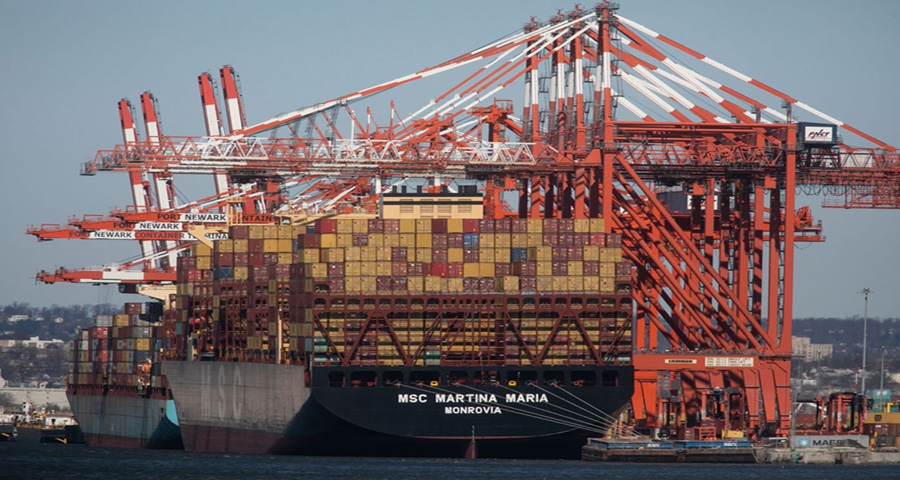U.S. Tariffs Drives “Foreign Trade Zone” Surge
KEY POINTS
- Importers are increasingly using Foreign Trade Zones to defer duties and reduce reliance on China-linked supply routes.
- Ocean bookings from Asia drop amid tariff uncertainty.
- Health systems use SRS to calculate tariff exposure for the items they buy.

Importers are turning to Foreign Trade Zones to manage tariff exposure and reroute supply chains.
The Trump administration’s tariffs on Chinese goods are leading U.S. companies to reassess supply chain strategies in response to evolving trade policies. A growing number of importers are shifting goods into U.S.-designated Foreign Trade Zones (FTZs) to temporarily shield themselves from tariff costs. FTZs, which allow goods to be stored or processed without triggering duties, have seen a surge in enrollment in recent months. According to port officials and trade consultants, companies are using these zones not just to defer tariffs, but also to reroute supply chains in ways that reduce exposure to Chinese origin products.
These adjustments at the port level are mirrored in broader shipping trends, where transpacific freight volumes are declining sharply amid growing uncertainty Container bookings from Asia to the U.S. plummeted in mid-April, with carriers reporting widespread cancellations and underutilized sailings. Industry analysts are calling it a “tariff shockwave,” as freight volumes collapse amid uncertainty over pricing, duties, and shipping schedules. Some major ocean carriers are slashing capacity on transpacific routes, while others are shifting assets to less volatile lanes.
Beyond shipping, U.S. manufacturers and distributors using just-in-time inventory models are revisiting safety stock strategies, while healthcare executives are assessing potential cost impacts, reevaluating sourcing locations, and reconfiguring risk across their logistics networks.
Any health system can tailor SRS to their suppliers and items in order to assess exposure to tariffs and other risks, gain supply chain transparency, and move from reactive to proactive risk mitigation. Contact SRS Support (support@supplyrisk.com).
The following SRS reports can be tailored to the items you buy to assess tariff exposure for your health system:
- “Products Tariffs – Special Report” – details suppliers sourcing from tariffed countries (in the Prevent dashboard).
- “Products by Country (Tariff Risk)” – choose any country to see which items you buy are manufactured there (in the Prevent dashboard).
- “Products Subject to Section 301 China Tariffs” – downloads current section 301 tariffs on healthcare item made in China (in the Prevent dashboard).
- “Products Sites and Risks” – lists manufacturing location for all items you buy from the supplier (in the Prevent dashboard after you drill down on a supplier).
- “Supplier Geopolitical Summary” – summarizes exposure for all countries (in the Respond dashboard).
If you have not yet tailored SRS for the items you buy, it’s easy to do so with an SRS subscription.
For more information, see:
CNN, Trump’s trade war will hit US prosperity hard, IMF warns, April 22
CNBC, Trump tariffs lead to surge of companies parking imports in tax-free ‘foreign trade zones’, April 21
Supply Risk Solutions, U.S. Launches Tariff Probes Into Chip and Pharmaceutical Imports, April 17
Freight Waves, ‘Tariff shockwave’ leads to collapse in ocean container bookings, April 15
Supply Risk Solutions, Supply Chains Upended by Historic Tariffs, April 3
Supply Risk Solutions, Manufacturers Plan to Pass Tariff Costs on to Their Customers, April 1
Association of Supply Chain Management, Relentless Tariffs and a Supply Chain Crossroads, March 28
Manufacturing.Net, Survey Uncovers Tariff Impact on Manufacturers and Their Adjustment Strategies, March 12
Supply Risk Solutions, Impact of Upcoming Tariffs on Healthcare Sourcing, March 11
Supply Risk Solutions, Trump’s Partial Tariff Exemptions Leave Majority of Canada-Mexico Duties in Place, March 7
Supply Risk Solutions, U.S. Tariffs on Canada and Mexico Take Effect, March 4
Supply Risk Solutions, U.S. Unveils New Tariff Plans, February 28
Supply Risk Solutions, Trump Confirms Canada and Mexico Tariffs Will Take Effect on March 4, February 25
Supply Risk Solutions, Trump Proposes 25% Tariffs on Cars, Chips, Pharma Products, February 20
Supply Risk Solutions, China Counters U.S. Tariffs with Targeted Tariffs, Export Controls, and Investigations, February 4
Supply Risk Solutions, Trump Delays Tariffs on Mexico and Canada, February 3
Supply Risk Solutions, U.S. to Impose Tariffs on Key Trading Partners Feb. 1, February 1
Supply Risk Solutions, Trump’s Tariff Policies Spark Global Uncertainty, January 27
Supply Risk Solutions, Trump Proposes 25% Tariffs on Canada and Mexico Starting February 1, January 21
Supply Risk Solutions, Tariff Planning Requires Product Transparency, January 13
Supply Risk Solutions, U.S. Tariff Plans Bring Urgency to Knowing Product Manufacturing Locations, December 2
Supply Risk Solutions, Tariffs Push Manufacturers to Rethink Supply Chain Strategies, November 15
Supply Risk Solutions, Tariffs Spur Urgency to Understand Product Manufacturing Locations, November 11
Supply Risk Solutions, List the Products You Buy That Are Subject to China Import Tariffs, October 28
White & Case, United States Finalizes Section 301 Tariff Increases on Imports from China, September 17